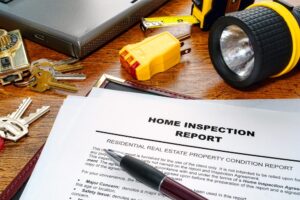 Buying a home is one of the biggest investments you’ll ever make, and a home inspection is a crucial step in ensuring that investment is sound. While no home is perfect, some issues uncovered in an inspection report can signal serious problems that could cost you thousands down the road. Here are some key red flags to watch for in home inspection reports.
Buying a home is one of the biggest investments you’ll ever make, and a home inspection is a crucial step in ensuring that investment is sound. While no home is perfect, some issues uncovered in an inspection report can signal serious problems that could cost you thousands down the road. Here are some key red flags to watch for in home inspection reports.
1. Foundation and Structural Issues
The foundation is the backbone of any home. If an inspection report highlights cracks in the foundation, uneven floors, or doors and windows that don’t close properly, these could indicate major structural problems. Repairing foundation issues can be extremely costly, and in some cases, the home may not be safe to live in until repairs are made.
2. Roof Damage or Poor Condition
A damaged or aging roof can lead to leaks, mold, and costly repairs. Look for signs such as missing shingles, sagging areas, or evidence of past leaks in the attic. A roof replacement can cost anywhere from $5,000 to $15,000 or more, depending on the size and material, so it’s essential to factor this into your buying decision.
3. Electrical System Deficiencies
Faulty wiring, outdated electrical panels, and overloaded circuits are not just inconveniences—they’re potential fire hazards. If an inspection report notes aluminum wiring, knob-and-tube wiring, or an insufficient number of grounded outlets, these could require significant upgrades to bring the home up to modern safety standards.
4. Plumbing Problems
Leaks, water pressure issues, or corroded pipes can indicate deeper plumbing concerns. Pay attention to signs of water damage, which could suggest hidden leaks behind walls. Older homes with galvanized pipes may need complete repiping, which can be a major expense.
5. HVAC System Deficiencies
Heating, ventilation, and air conditioning (HVAC) systems are expensive to repair or replace. An outdated or poorly maintained system may not function efficiently, leading to higher energy bills. If the inspection reveals issues such as dirty filters, improper installation, or a system nearing the end of its lifespan, be prepared for potential replacement costs.
6. Mold and Water Damage
Mold and mildew can indicate serious moisture problems and potential health hazards. Any sign of mold, water stains on ceilings or walls, or musty odors should be investigated further. Water damage can lead to costly structural repairs and should never be ignored.
7. Pest Infestations
Termites, carpenter ants, or rodent infestations can cause significant damage to a home’s structure. An inspection should identify any signs of pests, and a separate pest inspection may be necessary to fully assess the extent of the problem.
Final Thoughts
A home inspection report is a valuable tool for understanding a property’s condition. While some issues can be minor and easily fixed, others may require extensive repairs. If major red flags appear in an inspection, consider negotiating repairs with the seller or, in extreme cases, walking away. Being informed can save you from costly surprises and help you make a confident home-buying decision.
Compliments of Virtual Results






 Catch Our Feed
Catch Our Feed Subscribe via Email
Subscribe via Email Follow Our Tweets
Follow Our Tweets Friend Us On Facebook
Friend Us On Facebook Watch Us On Youtube
Watch Us On Youtube